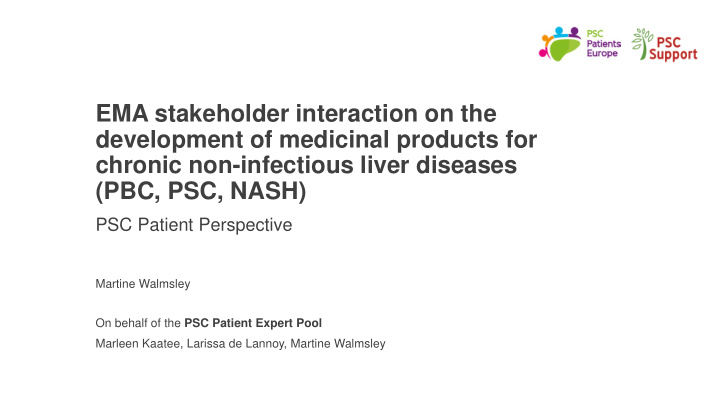



EMA stakeholder interaction on the development of medicinal products for chronic non-infectious liver diseases (PBC, PSC, NASH) PSC Patient Perspective Martine Walmsley On behalf of the PSC Patient Expert Pool Marleen Kaatee, Larissa de Lannoy, Martine Walmsley
The Impact of PSC ‘Patient age, sex, and inflammatory bowel disease phenotype associate with course of primary sclerosing cholangitis’ 7121 pts with PSC 1 o endpoint: LTx / death 2 o endpoint: HPB malignancy n = 721: n = 2616: - Cholangio Ca: 594 pts - LTx: 1696 pts - Gallbladder Ca: 58 pts - Death without LTx: 920 pts - HCC: 59 pts - Pancreatic Ca: 10 pts Weismüller*, Trivedi* et al. Gastroenterology , 2017
PSC: Daily Symptoms Sources: pscsupport.org.uk/unmetneeds and pscpatientseurope.org/psc-patients-survey
PSC: Living with PSC Sources: pscsupport.org.uk/unmetneeds and pscpatientseurope.org/psc-patients-survey
PSC: Living with PSC • Uncertainty and helplessness • Long term • Day to day • Physical and emotional burden “Trying to lead a normal life while suffering from symptoms that most people don’t understand or can't relate to.” Sources: pscsupport.org.uk/unmetneeds
Living better with PSC • Lived experience of PSC is a huge area of unmet need • Improvement includes a better quality of life • What patients want: “give me more peace of mind” “allow me to work” “allow me to lead an active life” Sources: pscpatientseurope.org/psc-patients-survey
Burden of Symptoms - Patient Reported Outcomes (PROs) • Use Patient Reported Outcomes as endpoints, especially: • Fatigue • Itch • Pain • Quality of life • Develop and validate/qualify Patient Reported Outcome Measures for use in clinical trials • Patients engaged in PROM-related activities • PSC PRO, UK-PSC Quality of Life Measure • Value of PROs post-authorisation (HTA)
Living longer with PSC • Patients don’t want an early death • Develop new medicines that show meaningful and convincing results to modify the disease in order to: • prolong life with PSC • reduce PSC complications • reduce bile duct infections • prevent or reduce risk of cancer • prevent or reduce occurrence of rPSC • predict progression of PSC
Validate Surrogate Endpoints • Co-ordinated development programmes towards validating novel non-invasive endpoints: • Use common exploratory endpoints • Use new and emerging technologies • Replace biopsies • Longer-term outcome observation • Share (placebo) data • Patients want to live longer , even if that’s with PSC
Real World PSC • Creative trial design to incorporate different phenotypes and medications: • co-existing diseases, ages, disease stage and severity, fibrosis, inflammation, colon/bile duct damage… • Biochemistry fluctuations and cholangitis • Screening windows and re-screening opportunity • Study impact of treatment on co-existing diseases • especially IBD • UDCA
Eligibility Criteria • Broader eligibility criteria Approve treatments for the majority, not the minority
Summary • Engage the PSC patient community • well-educated, well-organised and expertise within our networks • Act with urgency • Coordinate development programmes to validate/qualify endpoints • include non-invasive surrogates • include Patient Reported Outcomes always We want to live as well as possible, as long as possible
Thank you EMA PSC Patient Expert Pool Martine Walmsley, PSC Support martine@pscsupport.org.uk Larissa de Lannoy, PSC Patients Europe larissa@pscpatientseurope.org Marleen Kaatee, PSC Patients Europe marleen@pscpatientseurope.org
Recommend
More recommend